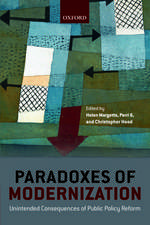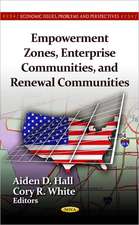Routledge Handbook of Politics and Technology
Editat de Ulrich Hilperten Limba Engleză Paperback – 17 mai 2018
- demand and support for new technologies and innovation by the state;
- the effects of technology policies;
- technology development and innovation difference between various countries and regions;
- policy instruments and techno-industrial innovation;
- dynamism and change as outcomes of government policies;
- driving forces for science and innovative development;
- skills, education and human capital.
| Toate formatele și edițiile | Preț | Express |
|---|---|---|
| Paperback (1) | 470.51 lei 6-8 săpt. | |
| Taylor & Francis – 17 mai 2018 | 470.51 lei 6-8 săpt. | |
| Hardback (1) | 1564.55 lei 6-8 săpt. | |
| Taylor & Francis – 8 oct 2015 | 1564.55 lei 6-8 săpt. |
Preț: 470.51 lei
Nou
Puncte Express: 706
Preț estimativ în valută:
90.04€ • 93.66$ • 74.34£
90.04€ • 93.66$ • 74.34£
Carte tipărită la comandă
Livrare economică 15-29 aprilie
Preluare comenzi: 021 569.72.76
Specificații
ISBN-13: 9781138609013
ISBN-10: 1138609013
Pagini: 516
Ilustrații: 38 Line drawings, black and white; 36 Tables, black and white; 38 Illustrations, black and white
Dimensiuni: 174 x 246 x 26 mm
Greutate: 0.95 kg
Ediția:1
Editura: Taylor & Francis
Colecția Routledge
Locul publicării:Oxford, United Kingdom
ISBN-10: 1138609013
Pagini: 516
Ilustrații: 38 Line drawings, black and white; 36 Tables, black and white; 38 Illustrations, black and white
Dimensiuni: 174 x 246 x 26 mm
Greutate: 0.95 kg
Ediția:1
Editura: Taylor & Francis
Colecția Routledge
Locul publicării:Oxford, United Kingdom
Public țintă
Postgraduate and UndergraduateCuprins
Introduction: 1. Introduction PART I: Dynamic development and the role of the state: demand and support for new technologies and innovation 2. Transatlantic comparison of continental innovation models. A differentiation of regionalised processes of innovation in Europe and the US 3. Technology and socio-economic development in the long run. A "long wave"-perspective 4. Recognizing opportunities for S&T workforce development and productivity. The gendered resource 5. Branding the innovation place. Managing the soft infrastructure of innovation PART II: Effects of technology policies: regional situations and how they form innovative networks 6. Universities, revolutions and continuity in regional innovation policies in Europe 7. Local clusters and global networks. The role of different dimensions of proximity 8. The regional innovation paradox revisited 9. The role of universities in the evolution of technology-based economic development policies in the United States PART III:Enabling government policies: technology development and innovation difference between innovative countries and regions10. Diversities and disparities in regional development. The role of culture 11. Explaining differences in the adaptability of old industrial areas12. Chinese geographical based innovation clustering. Major driving forces and their functions 13. Putting Singapore in the global innovation map. The shifting role of the state in the rapidly changing environment PART IV: Policy instruments: how to realise techno-industrial innovation 14. Governmental policies and technological innovation. Biotechnology and fast breeder reactor technology revisited 15. Korean government and science and technology development 16. 21st century universities as drivers for innovation. The dimensions of learning, research, and collaboration 17. Regional innovation policy and public-private partnerships 18. Ecosystems of open innovation. Their applicability to the growth and the development of economies within small countries and regions PART V: Effects of new technologies: dynamism and change as outcomes of government policies 19. Metropolitan locations in international high-tech networks. Collaboration and exchange of creative labour as a basis for advanced socio-economic development 20. Governance of biofuel production in the United States 21. Competition in international automotive and aerospace technologies 22. Nanotechnology for green and sustainable growth. A recent example on the co-evolutionary development of a technology PART VI: Important players and driving forces for science and innovative development: stability and change 23. The politics of technological innovation. The case of US solar industry 24. Clusters, unlike diamonds, are not forever. The European way to global competition 25. Institutional transformations of technology policy in East Asia. The rise of the entrepreneurial state 26. China’s path towards becoming a major world player in science and technology 27. Scientists' motivation to innovate, catch-up and collaborate. A trans-disciplinary perspective PART VII: Methods: How to analyse the role of the state and enabling policies: comparative research and interdisciplinary design 28. Innovation policies deserve a sound monitoring system. An agenda for policy makers 29. Outcomes-oriented innovation policy design. An analytic-diagnostic framework 30. Assessing the impact of knowledge transfer policies. An international comparison of models and indicators of universities’ knowledge transfer performance 31. Simulations in politics and technology. Innovation policies in the field of photovoltaic cells Conclusions: 32. Conclusions. New phenomena and advanced analysis – exploring variations for a deeper understanding of a rich diversity of technologies and innovations
Notă biografică
Ulrich Hilpert is Professor of Comparative Government at Friedrich Schiller University Jena, Germany. He is also a Fellow of the Academy of Social Sciences (AcSS), visiting professor at a dozen universities in Europe and the US, Chairman of the IPSA Research Council on Science and Politics, consultant to the EU and a number of national and regional governments, labour unions and business organisations.
Descriere
This handbook provides a comprehensive global survey of the politics of technology. Written by an outstanding line up of distinguished scholars in the field, the handbook covers all aspects of the relationship between politics and technology. Forming the basis of this handbook are examples of regional development, country studies and a rich variety of technologies, as well as topical issues such as divergent political interests in relation to technology and the economic exploitation of technologies. Employing a comparative and interdisciplinary approach in order to analyse the interplay between government activities and the development of new technologies, this handbook will be an invaluable resource for all students, scholars and practitioners working in the politics of technology, public policy and policy analysis.














